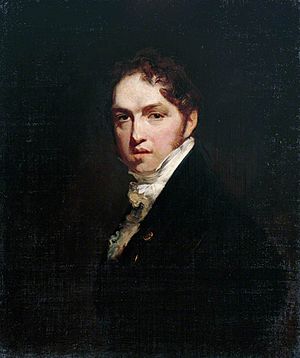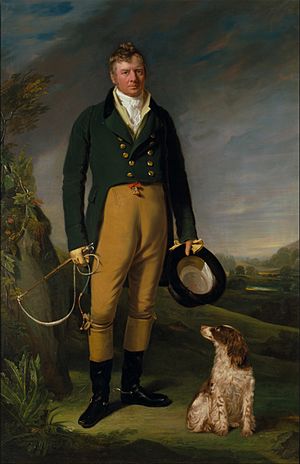William Owen (painter) facts for kids
Quick facts for kids
William Owen
|
|
|---|---|
| Born | 1769 Ludlow, Shropshire, England
|
| Died | 1825 (aged 55–56) London, England
|
| Alma mater | Royal Academy of Arts |
| Known for | Painting |
William Owen (1769–1825) was a famous English portrait painter. He was known for painting important people of his time. These included Pitt the Younger, who was the Prime Minister, and George, Prince of Wales, who later became King George IV.
Early Life
William Owen was born in 1769 in a town called Ludlow in England. He was baptized on November 3rd of that year. His father, Jeremiah Owen, ran a barber shop that later became a stationery and bookshop.
William showed his artistic talent from a very young age. He loved to sketch the beautiful places around him. One of his first known drawings was of Ludlow Castle. It is believed he gave this drawing to Lady Clive, a well-known lady of the time.
Painting Career
In 1786, William Owen moved to London to start his art career. He became an apprentice to Charles Cotton, a coach painter. An apprentice learns a trade by working for an experienced person. William's uncle likely helped him get this position.
Owen was very interested in painting people. He copied a portrait by the famous artist Sir Joshua Reynolds. This painting was of a popular actress named Mary Robinson. Because of his talent, Reynolds suggested Owen join the Royal Academy Schools in 1791. This was a very important art school.
By 1794, Owen had his own studio in Piccadilly, a busy part of London. He later moved his studio to Coventry Street in Haymarket. While living there, he likely met Lener Leaf, who would become his wife. Her father worked nearby as a shoemaker.
Around 1797, Owen worked as an assistant to John Hoppner, another well-known portrait painter. Hoppner was so busy that he needed help making copies of his paintings. Owen was also becoming successful on his own. In the same year, he painted a portrait of Lener and her younger sister. He showed this painting at Somerset House, where the Royal Academy held its exhibitions. The painting received a lot of praise.
Owen married Lener Leaf on December 2nd, 1797. Their son, William, was born soon after.
In 1800, Owen and his family moved to Pimlico. However, he kept his studio at Leicester Square, right next door to where Sir Joshua Reynolds used to live. Owen used this studio until he became too ill in 1818.
The years 1797 and 1798 were very important for Owen's career. In 1797, he painted William Pitt the Younger, who was the Prime Minister of Great Britain. The next year, he also exhibited a portrait of Alexander Wedderburn, who was the Lord Chancellor (a very important legal official).
Royal Appointment
In 1810, after John Hoppner passed away, William Owen received a special honor. He was chosen to be the portrait painter for the Prince of Wales. This prince later became King George IV.
Unfortunately, the prince never sat for Owen to paint him directly. So, Owen had to use earlier sketches made by Hoppner to create the prince's portrait. In 1813, Owen was offered a knighthood, which is a special title given by the King or Queen. However, he chose to decline it.
Health Challenges
In 1818, Owen moved from his home in Pimlico and his studio in Leicester Square to Bruton Street. He likely moved because his health was slowly getting worse. Despite this, he was still very eager to paint. He showed eight of his works at the Royal Academy the following year.
In 1819, Owen traveled to Bath to see a doctor named Mr. Hicks. However, this visit did not seem to help his health. He soon returned to London. By 1820, Owen was mostly confined to his bed. He stayed there, except for a brief six months in Chelsea in late 1824, until he passed away five years later.
Death
William Owen was very ill in his final years. He was confined to his bedroom and had trouble moving. He relied on medicine to help him feel better. Sadly, due to a mix-up with his medicines, he took a fatal dose and died hours later.
Owen was buried on March 19, 1825, in a private ceremony at Saint Luke's, Chelsea. His family and close friends attended, including other famous artists like Sir Thomas Lawrence and Sir Richard Westmacott.



